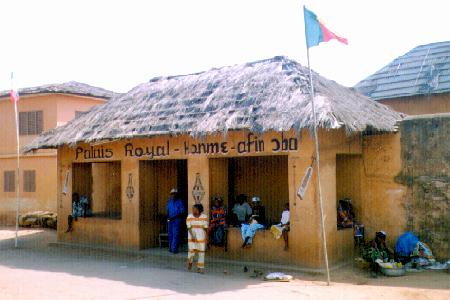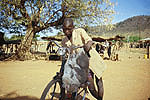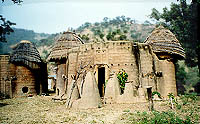|
With about 900.000 inhabitants Cotonou is the largest city of the country and the economic centre. It is a very busy
and hectic city, especially the vendors and thousands of motor taxis will catch your eye. The city doesn't really have
any monumental sights, but just the busy street life is quite a scene. A visit to the market is a unique experience.
You could almost call it a city within the city. Anything you could possibly think of is sold here: fabric, household
goods, vegetables, meat, fish, musical instruments, etc. Besides all that, there is a large voodoo section, where
dried animals, tree bark, spices, statues, and amulets are sold.
Ganvié is built on poles on lake Nokouhé. Life here turns around fishing. The men catch the fish in several ways.
You'll be able to see their fishing methods from the boat. The women sell the fish on the market of Cotonou. They
get there with their own little boat, or they take one of the, usually very full, boat taxis. In Ganvié everybody
uses boats as a means of transportation. To go visit the neighbours, to go shopping in the small store or on the
market, for every chore they use the pirogue. Even the market itself consists of several boats from which the
merchandise is sold.
Porto Novo is the capital of Benin and the administrative centre. With only 140.000 inhabitants it gives the image
of a small provincial town. It is beautifully situated on a lagoon. The anthropological museum gives a good
impression of the culture and traditions of Benin. The royal palace, where the kings used to live, is open to visitors.
It is striking to see with how little luxury they were surrounded. The Da Silva museum, at the former house of the
Da Silva family is quite new. The reconstructed rooms show something of the privileged position of the descendants
of the Brazilian slaves that returned to Benin.
The coastal town of Ouidah was one of the most important centres of slave trade in the 19th century. At the end of
the 18th century European slave traders started kidnapping slaves in order to sell them to North and South American
plantations. They traded weapons, munitions, fabrics, beads and utensils for prisoners of war of the kingdoms. It
didn't take long until the wars between the kingdoms didn't only turn around the appropriation or territories, but
especially around the acquisition of slaves. Southern Benin was called the "Slave coast" at those time. In the former
Portuguese fortress you can find a museum dedicated to this gruesome and dark period of history. You can walk to the
beach on the slave route to the monument in memory of the slaves, placed on the so called "point of no return". Here
the slaves had to say goodbye to their native land which they would never see again. For the people of Benin Ouidah
is especially famous for its powerful voodoo priests and fetishes. The snake temple has turned into a tourist
attraction, where you can be photographed with a snake around your neck. According to the guide, the snakes are set
free at the end of the day and wander through town. Along the roadside you will also be able to see different fetishes
and holy places.
Abomey used to be the residence of the kingdom of Dan-Homé, one of the most powerful kingdoms of Western Africa.
It is famous for its bloody wars and brave warriors. Especially the Amazons, the female elite army, was famous and
notorious. Almost everything exposed in the former palace, now a museum, has something to do with wars and fights.
Each king built his own palace, although now only a few of them are still standing. The surrounding fallow land gives
an impression of the vastness of the former palace complexes. The palaces with their beautiful bas-reliefs have been
skilfully restored and the guided tour is very instructive. In the museum you will also find a craft market, where you
can observe old craft methods and buy craft products. Apart from the museum, there are some old, un-restored palaces
and voodoo temples to be visited.
Natitingou is the most important town in the Northwest of Benin. The village is situated on a beautiful spot in a valley.
The temperature is very pleasant here. It is a good place to make excursions to the waterfalls and the other villages of
the area. You can visit the Somba museum, where you can find out about the culture and the architecture of the Somba
people.
The Somba people are known for their special way of construction and their rich traditions. Their homes, the so-called
Tata-Somba, look like little castles. They often have various floors and very thick walls without windows, which
apparently have to keep intruders out. Opposed to what is usual in Africa, the people don't live close to each other
in villages. Their houses are spread far apart over the land. Because of their isolated living space, the Somba have
managed to maintain their traditions. A project of SNV, the Dutch development-aid organization, has trained guides
and has taught women how to cook according to the Western hygiene standards. On several spots, special tourist
bathrooms were built. It is possible that the native population organizes dances for you. This will usually start
as a performance for tourists, but soon you will see the other people of the village join the party and you find
yourself in the middle of a village festival. The markets in this area are very traditional and local. Every four
days there is market, exactly the time is takes to brew fresh tsjouk, the local sorghumbeer.
The Pendjari park is one of the best places in West Africa to spot wildlife. Here you may see lions, buffaloes,
elephants, baboons and other monkeys, antelopes, bucks and many different types of birds. In and outside the park
you can spend the night in very simple to more elaborate hotels. Close to the park there are several waterfalls
that are worth a visit
The economy of Benin is dependent on subsistence production of maize, yams, cassava, rice, fruits and beans.
The country’s main exports are cotton, palm oil products, , coffee, crude oil and cocoa beans. Recent years
have seen an increase in exports of cotton and services related to transit trade. But the country’s productive
capacity is severely compromised by the under-utilization and misuse of existing technical expertise. In Cotonou
along the marina are many stalls selling handicrafts and souvenirs. The Dan Tokpa market borders the Cotonou Lagoon
and is stocked with many goods from Nigeria and elsewhere as well as traditional medicines and artifacts. Crafts and
local goods can be purchased in many towns and villages elsewhere, particularly in markets. Good buys include ritual
masks, tapestries, elongated statues and pottery.
Benin and the surrounding area was settled in the 13th century by Ewe speaking people in the south and by Voltaic
speakers in the north. Some time before 1600 the Adja people migrated from the west, mixed with the Fon and founded
the kingdom of Allada which broke up into the rival states at Abomey and Porto-Novo in the 17th. The first of these
grew into the Kingdom of Dahomey, which dominated the area until the 19th century.
Benin, formerly known as Dahomey, was a French colony from 1902 until it achieved independence in 1960. Military
officers led by Mathieu Kerekou took power in 1972, proclaiming a " Marxist-Leninist" state and changing the
country’s name. Benin renounced Marxist policies by the end of 1989 and in the following year became a multi-party
democracy. Prime Minister Nicephere Soglo defeated Mr. Kerekou to become President in the March 1991 election. However,
Mr. Kerekou was returned to office in the next election of 1996. Benin has embarked on a path of democracy which
is a model in Africa. Presidential elections in both 1991 and 1996 saw a peaceful transfer of power. Increased freedom
of the press and strengthening of civil society institutions have reinforced the country’s democratic tendencies.
The continuation of market-oriented economic policies after the 1996 election of President Kerekou has strengthened
reforms by demonstrating the broad political consensus around such policies. Dr Thomas Yayi Boni (born 1952), a Beninois
banker and politician, is the current President of Benin (2008). He took office on 6 April 2006 after winning elections
held in the previous month. Boni was born in Tchaourou, in the Borgou Department in northern Benin, then the French
colony of Dahomey. He was educated in the regional capital, Parakou, and later studied economics at the National
University of Benin. He studied banking at Cheikh Anta Diop University in Dakar, Senegal, and later economics and
politics at the University of Orléans in France and at Paris University, where he completed a doctorate in economics in 1976.
From 1980 to 1988 Boni worked for the Central Bank of the States of West Africa (BCEAO), becoming its Deputy Director,
based in Dakar. In 1988 he became Deputy Director for Professional Development at the West African Centre for Banking Studies,
also in Dakar. From 1992 to 1994 he worked in the office of the President of Benin, Nicéphore Soglo, in charge of monetary
and banking policy. Finally in 1994 he was appointed President of the West African Development Bank (BOAD). For his work
on West African development he was appointed Chevalier de l'Ordre National de Mérite of the French Republic.
In the first round of the presidential elections, held on 5 March, Boni polled 32 percent. His nearest challenger,
Adrien Houngbédji of the Party for Democratic Renewal, polled 25 percent. Twenty-six candidates contested the election,
which was reported to have been peaceful and fair. A runoff was held between Boni and Houngbédji on March 19; Boni won
with almost 75 percent of the vote. Originally from a Muslim family, Boni is now an Evangelical Protestant. He has five
children, and his wife Chantal (née de Souza), a native of the coastal city of Ouidah, is the niece of the former military
ruler Paul-Émile de Souza.
|





